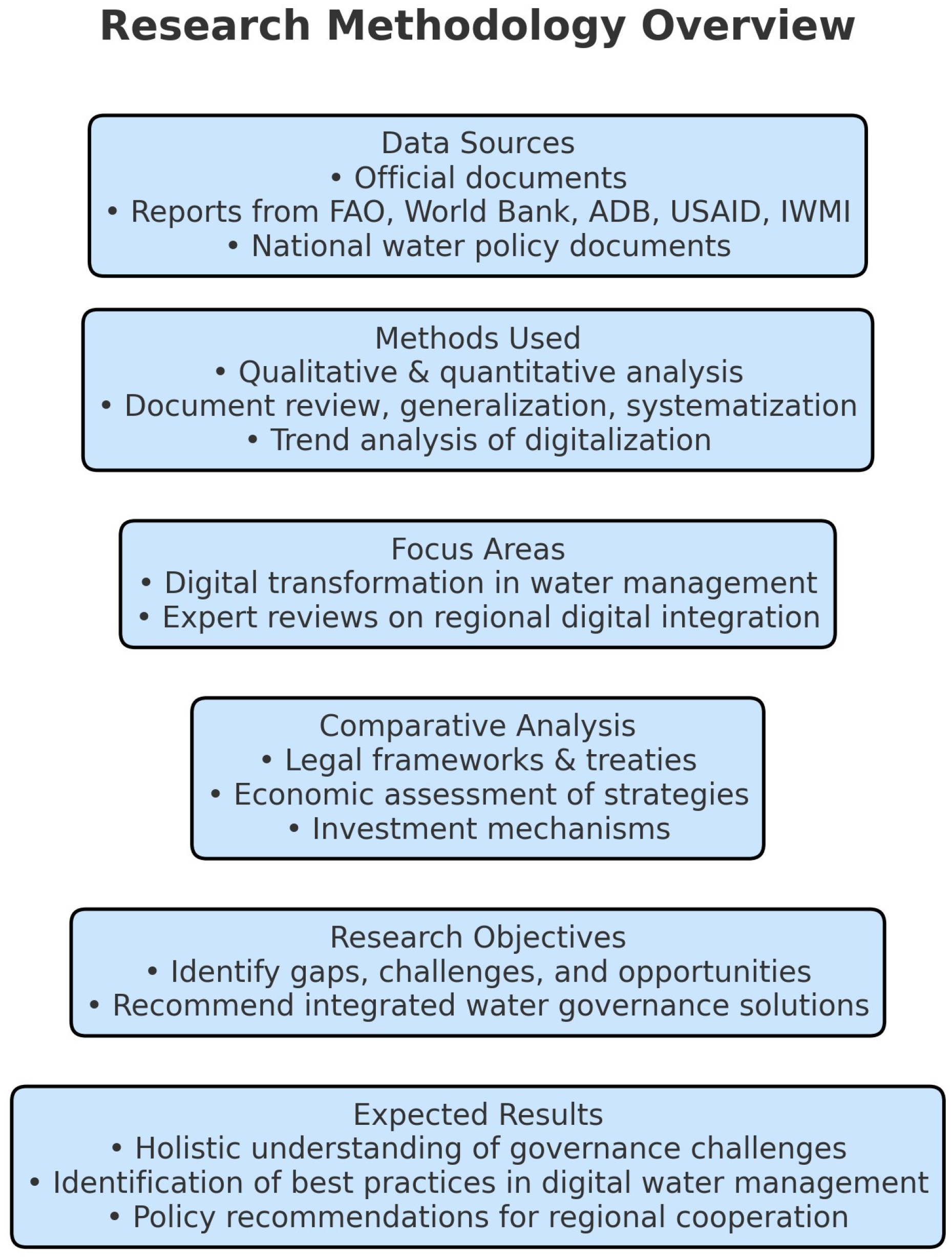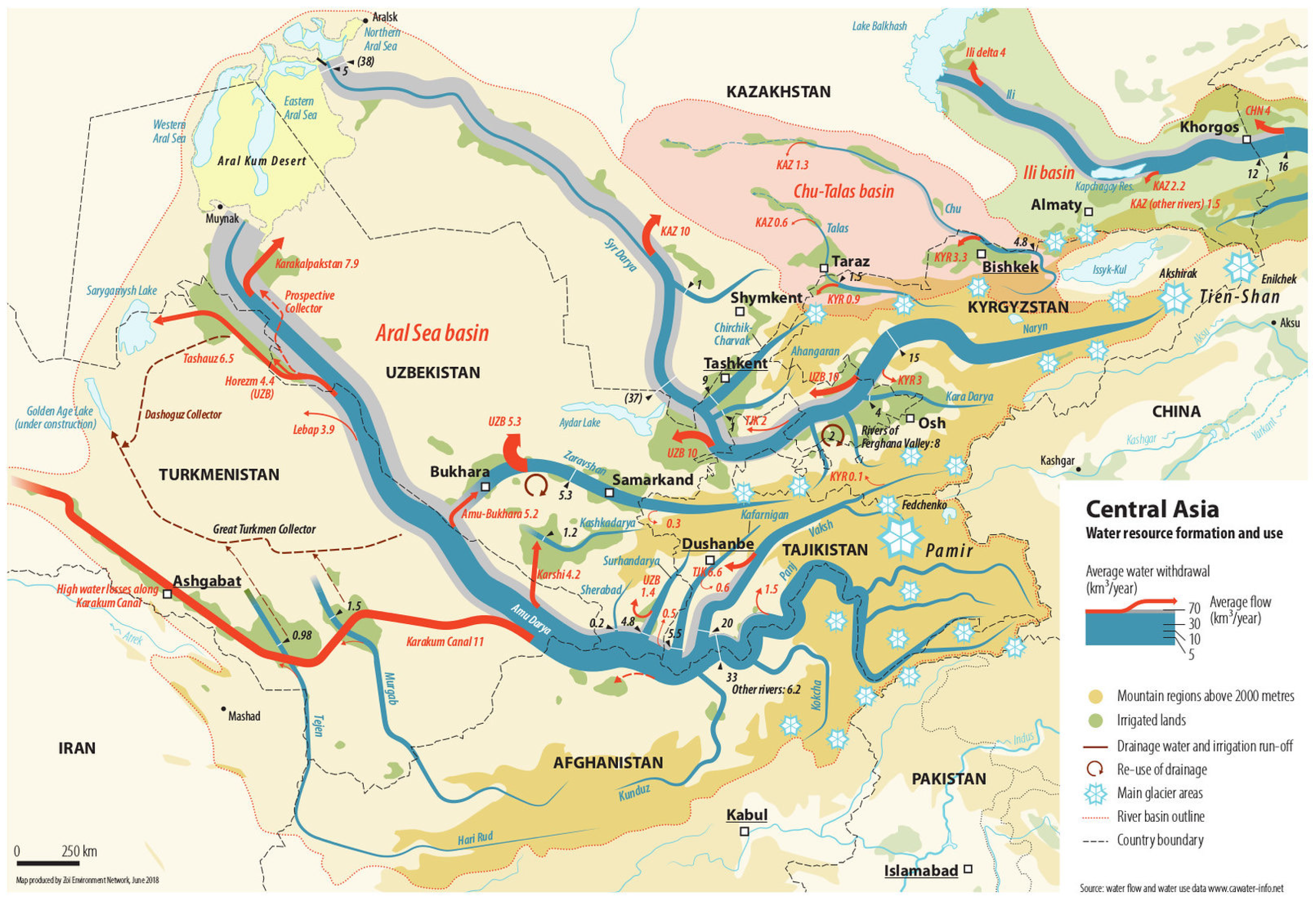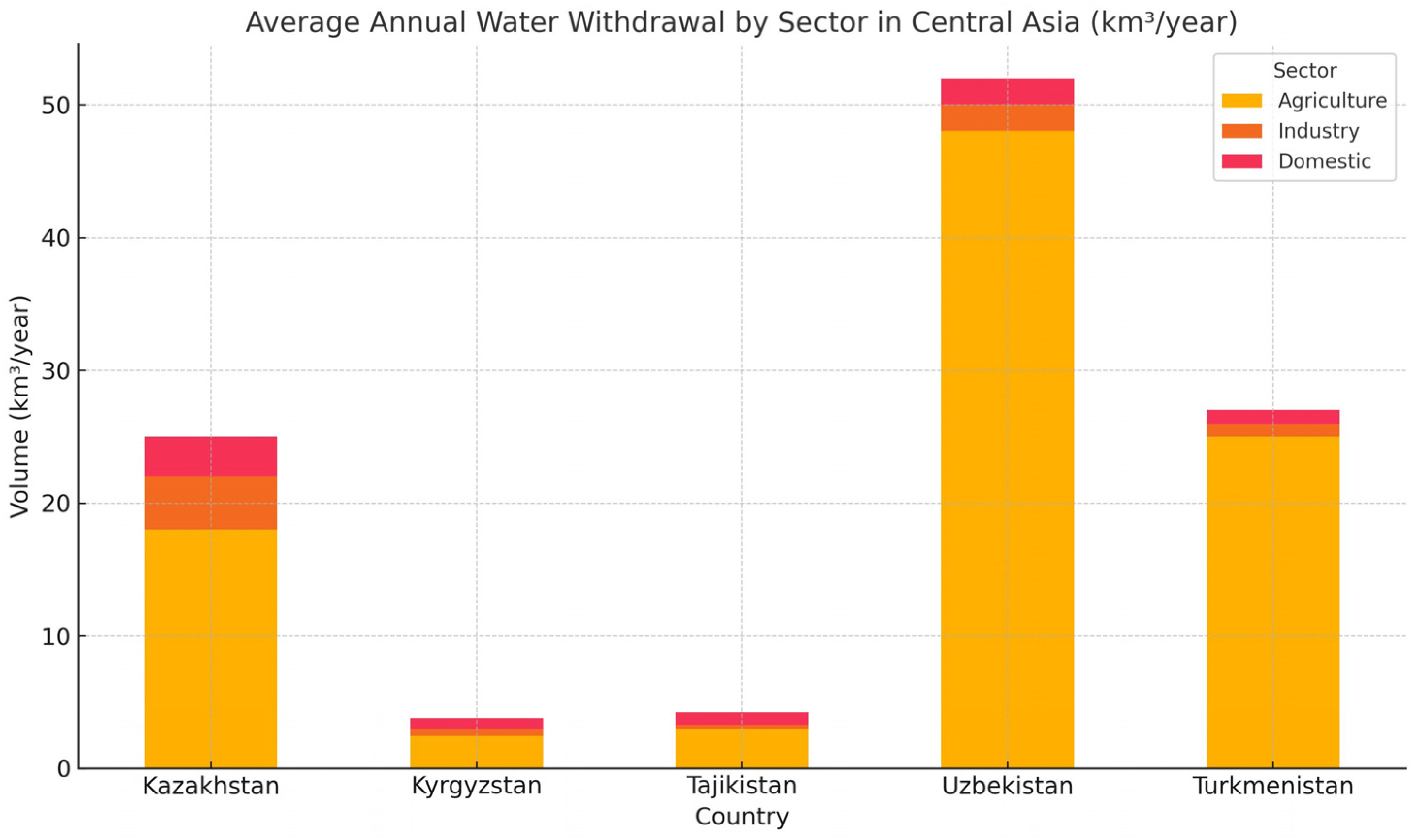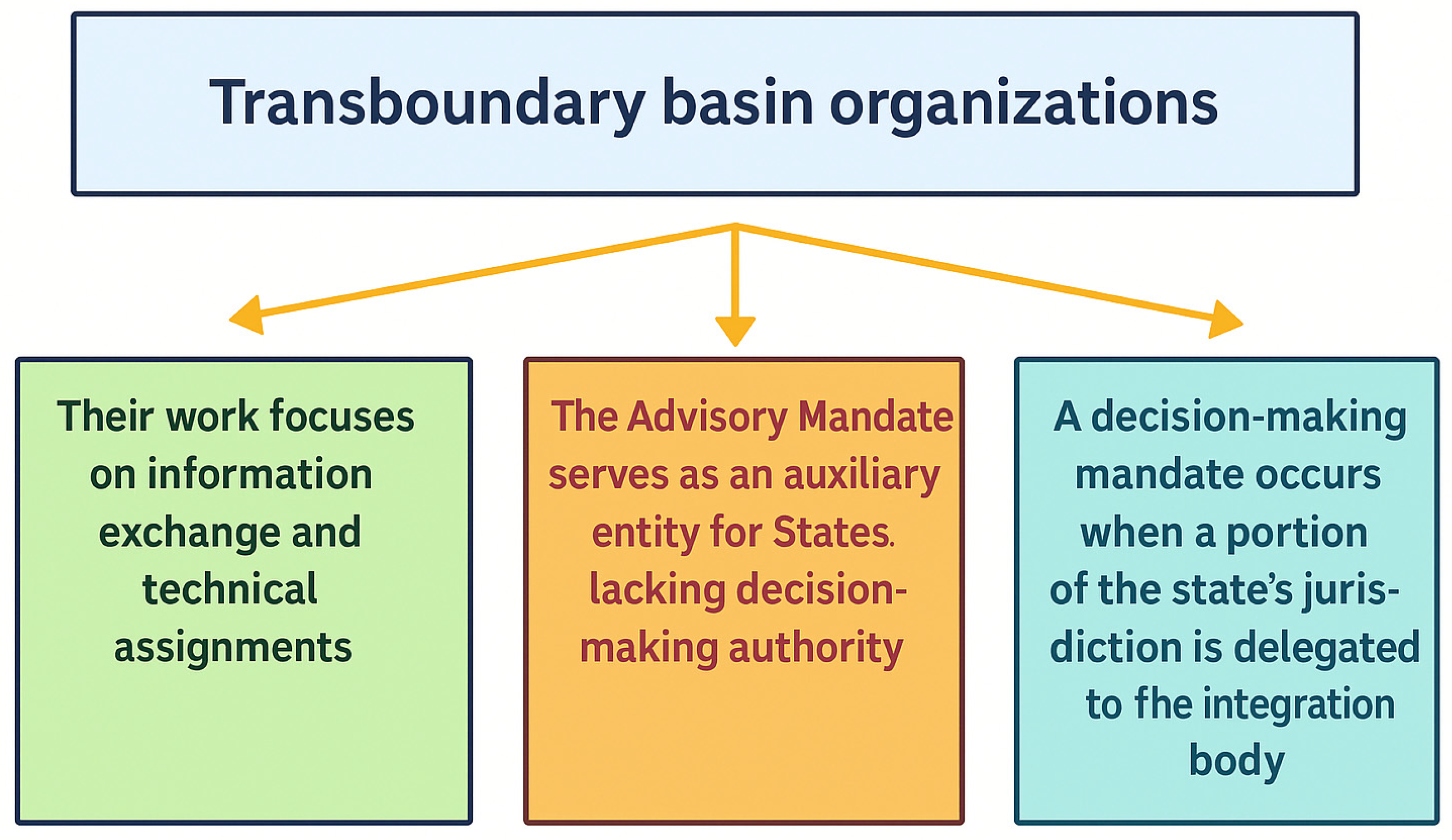Sustainable Transboundary Water Governance in Central Asia: Challenges, Conflicts, and Regional Cooperation
Abstract
1. Introduction
- to provide a historical and policy-oriented overview of water management practices in the region;
- to assess current legal frameworks and geopolitical tensions through case studies, such as the Aral Sea basin and Qush Tepa Canal;
- to present recommendations for developing sustainable, equitable, and technologically advanced solutions, including greater use of digital water monitoring tools and improved regional coordination.
2. Research Methods
3. Results
3.1. Water Resource Management in Central Asia: Historical Context and Contemporary Challenges
- BO Amu Darya oversees 84 hydropower stations, including 36 head river water intakes, 169 hydro posts, and 386 km of interstate canals in Tajikistan, Turkmenistan, and Uzbekistan.
- BO Syr Darya manages 198 hydraulic structures, with 21 located on major tributaries, such as the Naryn, Syr Darya, Karadarya, and Chirchik rivers.
3.2. Legal and Institutional Framework for Water Governance in Central Asia
- International Treaties and Agreements—All international water-related treaties ratified by the Republic of Kazakhstan, which establish frameworks for transboundary water cooperation and management.
- Constitutional Provisions—Article 6 of the Constitution of the Republic of Kazakhstan, which defines the legal status and ownership of natural resources, including water.
- National Water and Environmental Legislation—Key legislative acts governing water resource management, including:
- Water Code of the Republic of Kazakhstan (9 July 2003, No. 481-II);
- Code on Administrative Offenses (9 January 2007, No. 212-III);
- Environmental Code (2007);
- Land Code (20 June 2003, No. 442-II).
- National Water Resource Management Strategy—Presidential Decree approving the National Plan for Integrated Water Resource Management and Water Use Efficiency Improvement (2009–2025), aimed at ensuring sustainable water use and addressing water security challenges.
- Government Regulations and Policy Frameworks—Resolutions and legislative acts that influence public administration and regulatory mechanisms for water resource management, such as the Resolution of the Government of Kazakhstan (28 January 2009, No. 67).
- Regulatory Framework for Water Governance—National laws and regulations that govern water use, conservation, and distribution, ensuring compliance with environmental and sustainability standards.
- Subordinate Legislative Acts—Sector-specific regulations and executive orders that support the implementation of national water policies and ensure alignment with broader environmental objectives.
- Customary Practices in Water Management—Traditional and regionally accepted practices influencing business and community-level water use, particularly in rural and agricultural sectors.
- Economic and Trade-Related Water Regulations—Legislative frameworks governing water-related business activities, including commercial water use, hydropower development, and irrigation for agricultural enterprises.
- Public–Private Partnership and Stakeholder Engagement Mechanisms—Policies and initiatives facilitating collaboration between the government, private sector, and civil society in water resource management, ensuring inclusive and sustainable governance.
3.3. Transboundary Basin Organizations and Their Challenges
3.4. Institutional Stability and International Best Practices
3.5. Technical Recommendations for Advancing Water Resource Management Through Digital Innovation
3.6. Role of International Organizations in Central Asia’s Water Sector
4. Discussion
4.1. Water Resources Management in Central Asia
4.2. Legal and Institutional Frameworks for Transboundary Water Governance in Central Asia
4.3. Technological Innovation and Its Role in Water Governance in Central Asia
5. Conclusions
Author Contributions
Funding
Institutional Review Board Statement
Informed Consent Statement
Data Availability Statement
Acknowledgments
Conflicts of Interest
References
- Koncagül, E.; Connor, R. The United Nations World Water Development Report 2023: Partnerships and Cooperation for Water; Facts, Figures and Action Examples; UNESCO: Paris, France, 2023. [Google Scholar]
- Abdullaev, I.; Assubayeva, A.; Bobojonov, I.; Djanibekov, N.; Dombrowsky, I.; Gafurov, A.; Hamidov, A.; Herrfahrdt-Pähle, E.; Janusz-Pawletta, B.; Ishangulyyev, R.; et al. Current Challenges in Central Asian Water Governance and their Implications for Research, Higher Education, and Science-Policy Interaction. Cent. Asian J. Water Res. 2025, 11, 47–58. [Google Scholar] [CrossRef]
- Janusz-Pawletta, B. Current Legal Challenges to Institutional Governance of Transboundary Water Resources in Central Asia and Joint Management Arrangements. Environ. Earth Sci. 2015, 73, 887–896. [Google Scholar] [CrossRef]
- McKinney, D.C. Cooperative Management of Transboundary Water Resources in Central Asia. In The Tracks of Tamerlane: Central Asia’s Path to the 21st Century; National Defense University: Washington, DC, USA, 2004; pp. 187–220. [Google Scholar]
- Mukhammadiev, B. Challenges of Transboundary Water Resources Management in Central Asia. In the Aral Sea: The Devastation and Partial Rehabilitation of a Great Lake; Springer: Berlin/Heidelberg, Germany, 2013; pp. 233–251. [Google Scholar]
- Wang, X.; Chen, Y.; Li, Z.; Fang, G.; Wang, F.; Hao, H. Water Resources Management and Dynamic Changes in Water Politics in the Transboundary River Basins of Central Asia. Hydrol. Earth Syst. Sci. 2021, 25, 3281–3299. [Google Scholar] [CrossRef]
- Janusz-Pawletta, B.; Gubaidullina, M. Transboundary water management in Central Asia, Legal framework to strengthen interstate cooperation and increase regional security. Cah. D’asie Cent. 2015, 25, 195–215. [Google Scholar]
- Xenarios, S.; Shenhav, R.; Abdullaev, I.; Mastellari, A. Current and Future Challenges of Water Security in Central Asia. In Global Water Security: Lessons Learnt and Long-Term Implications; Springer: Berlin/Heidelberg, Germany, 2018; pp. 117–142. [Google Scholar]
- Amirova, I.; Petrick, M.; Djanibekov, N. Community, State and Market: Understanding Historical Water Governance Evolution in Central Asia; IAMO: Halle, Germany, 2022. [Google Scholar]
- Punkari, M.; Droogers, P.; Immerzeel, W.; Korhonen, N.; Lutz, A.; Venäläinen, A. Climate Change and Sustainable Water Management in Central Asia. In ADB Central and West Asia Working Paper Series; ADB: Mandaluyong, Philippines, 2014. [Google Scholar]
- Isaev, E.; Murata, A.; Fukui, S.; Sidle, R.C. High-Resolution Dynamic Downscaling of Historical and Future Climate Projections Over Central Asia. Cent. Asian J. Water Res. 2024, 10, 91–114. [Google Scholar] [CrossRef]
- Sadyrov, S.; Isaev, E.; Tanaka, K.; Murata, A.; Sidle, R.C. High-Resolution Assessment of Climate Change Impacts on the Surface Energy and Water Balance in the Glaciated Naryn River basin, Central Asia. J. Environ. Manag. 2025, 374, 124021. [Google Scholar] [CrossRef]
- Bernauer, T.; Siegfried, T. Climate change and international water conflict in Central Asia. J. Peace Res. 2012, 49, 227–239. [Google Scholar] [CrossRef]
- Reyer, C.P.; Otto, I.M.; Adams, S.; Albrecht, T.; Baarsch, F.; Cartsburg, M.; Coumou, D.; Eden, A.; Ludi, E.; Marcus, R.; et al. Climate Change Impacts in Central Asia and their Implications for Development. Reg. Environ. Chang. 2017, 17, 1639–1650. [Google Scholar] [CrossRef]
- Siegfried, T.; Bernauer, T.; Guiennet, R.; Sellars, S.; Robertson, A.W.; Mankin, J.; Bauer-Gottwein, P.; Yakovlev, A. Will Climate Change Exacerbate Water Stress in Central Asia? Clim. Chang. 2012, 112, 881–899. [Google Scholar] [CrossRef]
- White, C.J.; Tanton, T.W.; Rycroft, D.W. The Impact of Climate Change on the Water Resources of the Amu Darya Basin in Central Asia. Water Resour. Manag. 2014, 28, 5267–5281. [Google Scholar] [CrossRef]
- Kong, L.; Li, Y.; Ma, L.; Zhang, J.; Deng, X.; Abuduwaili, J.; Gulayozov, M. Climate Change Impacts and Atmospheric Teleconnections on Runoff Dynamics in the Upper-Middle Amu Darya River of Central Asia. Water 2025, 17, 721. [Google Scholar] [CrossRef]
- Kozhagulov, S.; Adambekova, A.A.; Quadrado, J.C.; Salnikov, V.; Rysmagambetova, A.; Tanybayeva, A. Trends in Atmospheric Emissions in Central Asian Countries Since 1990 in the Context of Regional Development. arXiv 2025. [Google Scholar] [CrossRef]
- Sidle, R.; Caiserman, A.; Khojazoda, Z.; Salazar, Á. Dynamics in the Water Towers of the Pamir and Downstream Consequences. arXiv 2022. [Google Scholar] [CrossRef]
- Rogers, A. Predicting Biodiversity Loss: A Global Analysis of Red List Index Trends and Key Drivers (2002–2021). Available online: https://papers.ssrn.com/sol3/papers.cfm?abstract_id=5106872 (accessed on 11 April 2025).
- Toymbaeva, D.; Mamatova, D.; Ergashev, X. Geoecological Problems of Uzbekistan and their Impact on the Region. Web Humanit. J. Soc. Sci. Humanit. Res. 2025, 3, 15–26. [Google Scholar]
- Wang, X.; Li, Y.; Gong, Y.; Liu, Y.; Zhao, J.; Li, K. Spatiotemporal Dynamics and Driving Mechanism of Aboveground Biomass Across Three Alpine Grasslands in Central Asia over the Past 20 Years Using Three Algorithms. Remote Sens. 2025, 17, 538. [Google Scholar] [CrossRef]
- Wang, X.; Zeng, Y.; Wang, P.; Ye, M.; Wang, D.; Lv, G. Scale effects of spatial patterns of ecosystem services in the Tarim River Basin in Central Asia. Environ. Monit. Assess. 2025, 197, 241. [Google Scholar] [CrossRef]
- Sidle, R.C.; Caiserman, A.; Jarihani, B.; Khojazoda, Z.; Kiesel, J.; Kulikov, M.; Qadamov, A. Sediment sources, erosion processes, and interactions with climate dynamics in the Vakhsh River Basin, Tajikistan. Water 2023, 16, 122. [Google Scholar] [CrossRef]
- Asian Development Bank. In Numbers: Climate Change in Central Asia. Available online: https://www.adb.org/ru/news/features/numbers-climate-change-central-asia (accessed on 24 February 2025).
- World Bank. Country Profiles with Climate Risks. Available online: https://climateknowledgeportal.worldbank.org/country-profiles (accessed on 21 February 2025).
- Piazza, S.; Sambito, M.; Maglia, N.; Puoti, F.; Raimondi, A. Enhancing urban water resilience through stormwater reuse for toilet flushing. Sustain. Cities Soc. 2025, 119, 106074. [Google Scholar] [CrossRef]
- Karchegani, A.M.; Mohammadpour, A.; Tavakoli, M. Assessing the Determinants of Effective Transboundary Water Resource Management Strategies in the Harirud River Basin, Iran. Int. J. Coast. Offshore Environ. Eng. 2024, 9, 42–55. [Google Scholar]
- Spoor, M.; Thiemann, L. Hydro-Authoritarianism: Mega-Engineering the (Semi-) Arid Regions of Central Eurasia and China. Eur.-Asia Stud. 2025, 77, 278–299. [Google Scholar] [CrossRef]
- Feng, K.; Cao, Y.; Du, E.; Zhou, Z.; Zhang, Y. Spatiotemporal Dynamics of Drought and the Ecohydrological Response in Central Asia. Remote Sens. 2025, 17, 166. [Google Scholar] [CrossRef]
- Karimov, A.; Giordano, M.; Mukherji, A.; Borisov, V.; Djumanov, J. Of Transboundary Basins, Integrated Water Resources Management (IWRM) and Second Best Solutions: The Case of Groundwater Banking in Central Asia. Water Policy 2012, 14, 99–111. [Google Scholar] [CrossRef]
- Michael, B. Approaches to optimize Uzbekistan’s Investment in Irrigation Technologies. Экoнoмuчecкaя Пoлumuкa 2020, 15, 136–147. [Google Scholar]
- Bhat, S.A.; Wani, M.I.; Irfan, P.S.U. Renewable and Non-Renewable Energy Potential of Central Asian States: An Analysis in Market Demand. Available online: https://ssrn.com/abstract=5106174 (accessed on 11 April 2025).
- Chowdhury, A.; Tadjoeddin, Z.; Vidyattama, Y. Landlocked Central Asia: The Peril of Transition. In Structural Transformation as Development: Path Dependence and Geopolitics; Springer: Berlin/Heidelberg, Germany, 2025; pp. 173–202. [Google Scholar]
- Aituarova, G.; Kh, T.L. The Role of International and Regional Organizations in Solving the Problem of Water Shortage in Central Asia. Becmнuк нaукu 2025, 4, 352–358. [Google Scholar]
- Balas, A. The European Union’s Role in Addressing Environmental Disputes in Central Asia: Evaluating the Effectiveness of a “Reluctant 3rd Party”. In European Union Governance in Central Asia; Routledge: Oxfordshire, UK, 2025; pp. 111–130. [Google Scholar]
- Goziyev, R. The Challenges of Maintaining Regional Security in Central Asia Amid Modern Threats. In International Relations Dynamics in the 21st Century: Security, Conflicts, and Wars; IGI Global Scientific Publishing: Hershey, PA, USA, 2025; pp. 349–368. [Google Scholar]
- Qudbidinova, K. Dehydration Challenges in Central Asia: A Looming Crisis. Web Sci. Sch. J. Multidiscip. Res. 2025, 3, 141–148. [Google Scholar]
- Horsman, S. Transboundary Water Management and Security in Central Asia. In Limiting Institutions; Manchester University Press: Manchester, UK, 2018; pp. 86–104. [Google Scholar]
- Anghelescu, A.-M.; Onel, I.-D. The EU’s Green Normative Power in Central Asia: The Case of the Aral Sea and Water Management Policies in Kazakhstan and Uzbekistan. In European Union Governance in Central Asia; Routledge: Oxfordshire, UK, 2025; pp. 91–110. [Google Scholar]
- Brody, M.; Kulikov, M.; Orunbaev, S.; Van Oevelen, P.J. The Global Energy and Water Exchanges (GEWEX) Project in Central Asia: The Case for a Regional Hydroclimate Project; Springer: Berlin/Heidelberg, Germany, 2024; pp. 777–783. [Google Scholar]
- van Oevelen, P.; Orunbaev, S.; Kulikov, M.; Brody, M. A New Gewex Regional Hydroclimate Activity in Central Asia. In Proceedings of the EGU General Assembly Conference Abstracts, Vienna, Austria, 14–19 April 2024; p. 11808. [Google Scholar]
- Faqiryar, J.N. Food-Climate Nexus in the North River Basin of Afghanistan: A Case Study of the Qush Tepa National Irrigation Canal. MISC 2024, 65. Available online: https://www.ssoar.info/ssoar/handle/document/94367 (accessed on 12 April 2025).
- Kuchins, A.C.; Aidarkhanova, E.; Sadid, N.; Barakzai, Z. Afghanistan’s Qoshtepa Canal and Water Security in Central Asia; Center for the National Interest: Washington, DC, USA, 2024. [Google Scholar]
- Sarbiland, H.; Stanikzai, I. Qosh Tepa Canal Impact on Economic Development: Historical Significance and Assessing SDGs 2030 in Afghanistan. Educ. Adm. Theory Pract. 2024, 30, 593–601. [Google Scholar] [CrossRef]
- Wesch, S. Central Asia: Challenges and Opportunities by Way of the Middle Corridor. In Climate. Changes. Security: Navigating Climate Change and Security Challenges in the OSCE Region; Federal Ministry of Defence: Vienna, Austria, 2024; pp. 175–193. Available online: https://www.bmlv.gv.at/pdf_pool/publikationen/book_climate_10_central_asia_challenges_and_opportunities.pdf (accessed on 12 April 2025).
- Taganova, J. A water diplomacy expert discusses the prospects of water conflict and cooperation in Central Asia. Global Voices, 31 August 2022. [Google Scholar]
- Mamatova, Z.; Ibrokhimov, D.; Dewulf, A. The wicked problem of Dam governance in Central Asia: Current trade-offs, future challenges, prospects for cooperation. Int. J. Water Gov. 2016, 4, 1–10. [Google Scholar]
- Vinokurov, E.; Ahunbaev, A.; Usmanov, N.; Sarsembekov, T. Regulation of the Water and Energy Complex of Central Asia; Eurasian Development Bank: Almaty, Moscow, 2022. [Google Scholar]
- Khikmatov, F.; Frolova, N.; Turgunov, D.; Khikmatov, B.; Ziyayev, R. Hydrometeorological conditions of low-water years in the mountain rivers of Central Asia. Int. J. Sci. Technol. Res. 2020, 9, 2880–2887. [Google Scholar]
- Hamidov, A.; Kasymov, U.; Salokhiddinov, A.; Khamidov, M. How Can Intentionality and Path Dependence Explain Change in Water-Management Institutions in Uzbekistan? Int. J. Commons 2020, 14, 16–29. [Google Scholar] [CrossRef]
- Formation of Surface Runoff Water Resources in the Aral Sea Basin. Available online: http://www.cawater-info.net/aral/water.htm (accessed on 25 October 2018).
- Berdiyev, A. Concept for the Development of the Water Management Sector in Turkmenistan. Document for Discussions, Changes, and Additions. 2018. Available online: https://www.undp.org/turkmenistan/projects/energy-efficiency-and-renewable-energy-sustainable-water-management-turkmenistan (accessed on 25 May 2025).
- Republic of Kazakhstan. Water Code of the Republic of Kazakhstan; Legal Information System of Regulatory Legal Acts of the Republic of Kazakhstan: Astana, Kazakhstan, 2003. [Google Scholar]
- Republic of Kazakhstan. Message of the President of the Republic of Kazakhstan N. Nazarbayev to the People of Kazakhstan. 14 December 2012. Available online: http://www.akorda.kz/ru/addresses/addresses_of_president/poslanie-prezidenta-republics-kazakhstan-nnazarbaeva-narodu-kazahstana-14-dekabrya-2012-g (accessed on 25 October 2018).
- Republic of Kazakhstan. Strategy “Kazakhstan-2050”. Available online: http://www.akorda.kz/ru/official_documents/strategies_and_programs (accessed on 25 October 2018).
- Kyrgyz Republic. Sustainable Development Strategy of the Kyrgyz Republic for 2018–2040 (Project) “TAZA KOOM. ZHANGY DOOR”; Uzbekistan. 2017. Available online: https://adam.kg/media/uploads/2022/04/15/national-strategy-of-kyrgyz-republic-2018-2040.pdf (accessed on 25 May 2025).
- Turkmenistan. Water Code of Turkmenistan. 2004. Available online: https://cis-legislation.com/document.fwx?rgn=89883 (accessed on 25 May 2025).
- Turkmenistan. National Climate Change Strategy of Turkmenistan; Food and Agriculture Organization of the United Nations: Rome, Italy, 2018. [Google Scholar]
- Republic of Uzbekistan. Law on Water and Water Use; Food and Agriculture Organization of the United Nations: Rome, Italy, 1993. [Google Scholar]
- Republic of Uzbekistan. Strategy of Action on Five Priority Directions of Development of the Republic of Uzbekistan in 2017–2021. Available online: http://old.lex.uz/pages/getpage.aspx?lact_id=3107042 (accessed on 25 October 2018).
- Libert, B.; Lipponen, A. Challenges and Opportunities for Transboundary Water Cooperation in Central Asia: Findings from UNECE’s Regional Assessment and Project Work. Int. J. Water Resour. Dev. 2012, 28, 565–576. [Google Scholar] [CrossRef]
- Mosello, B. Water in Central Asia: A Prospect of Conflict or Cooperation? J. Public Int. Aff. 2008, 19, 151,156–157. [Google Scholar]
- Xie, L.; Ibrahim, I.A. Is the ecosystem approach effective in transboundary water systems: Central Asia as a case study? Wiley Interdiscip. Rev. Water 2021, 8, e1542. [Google Scholar] [CrossRef]
- Izquierdo, L.; Stangerhaugen, M.; Castillo, D.; Nixon, R.; Jimenez, G. Water crisis in Central Asia: Key challenges and opportunities. Grad. Program Int. Aff. New Sch. Univ. 2010, 7, 4–53. [Google Scholar]
- Duzdaban, E. Water issue in Central Asia: Challenges and opportunities. Eurasian Res. J. 2021, 3, 45–62. [Google Scholar]
- Amirova, I.; Petrick, M.; Djanibekov, N. Long- and short-term determinants of water user cooperation: Experimental evidence from Central Asia. World Dev. 2019, 113, 10–25. [Google Scholar] [CrossRef]
- Sidle, R.C.; Khan, A.A.; Caiserman, A.; Qadamov, A.; Khojazoda, Z. Food security in high mountains of Central Asia: A broader perspective. BioScience 2023, 73, 347–363. [Google Scholar] [CrossRef]
- Kasymov, U.; Hamidov, A. Comparative Analysis of Nature-Related Transactions and Governance Structures in Pasture Use and Irrigation Water in Central Asia. Sustainability 2017, 9, 1633. [Google Scholar] [CrossRef]




| Indicators | Turkmenistan | Kazakhstan | Kyrgyzstan | Uzbekistan | Tajikistan |
|---|---|---|---|---|---|
| Irrigated land | 0.146 | 0.035 | 0.102 | 0.458 | 0.227 |
| Industry | 28,916 | 11,556 | 5504 | 12,026 | 1643 |
| Services | 19,228 | 31,380 | 17,298 | 14,026 | 5472 |
| General indicators | 1525 | 7201 | 0.842 | 1431 | 0.882 |
| State | River Basin | Aral Sea Basin | ||
|---|---|---|---|---|
| Syr Darya | Amu Darya I | km3 | % | |
| Kazakhstan | 2516 | - | 2516 | 2.2 |
| Kyrgyzstan | 27,542 | 1654 | 29,196 | 25.2 |
| Tajikistan | 1005 | 58,732 | 59,737 | 51.5 |
| Turkmenistan | - | 1405 | 1405 | 1.2 |
| Uzbekistan | 5562 | 6791 | 12,353 | 10.6 |
| Afghanistan and Iran | - | 10,814 | 10,814 | 9.3 |
| Aral Sea Basin Summary | 36,625 | 79,396 | 116,021 | 100 |
| State | Key Regulatory and Legal Acts on Water Resources | National Water Strategy |
|---|---|---|
| Republic of Kazakhstan |
|
|
| Republic of Kyrgyzstan |
|
|
| Republic of Uzbekistan |
|
|
| Republic of Tajikistan |
|
|
| Republic of Turkmenistan |
|
|
Disclaimer/Publisher’s Note: The statements, opinions and data contained in all publications are solely those of the individual author(s) and contributor(s) and not of MDPI and/or the editor(s). MDPI and/or the editor(s) disclaim responsibility for any injury to people or property resulting from any ideas, methods, instructions or products referred to in the content. |
© 2025 by the authors. Licensee MDPI, Basel, Switzerland. This article is an open access article distributed under the terms and conditions of the Creative Commons Attribution (CC BY) license (https://creativecommons.org/licenses/by/4.0/).
Share and Cite
Prniyazova, A.; Turaeva, S.; Turgunov, D.; Jarihani, B. Sustainable Transboundary Water Governance in Central Asia: Challenges, Conflicts, and Regional Cooperation. Sustainability 2025, 17, 4968. https://doi.org/10.3390/su17114968
Prniyazova A, Turaeva S, Turgunov D, Jarihani B. Sustainable Transboundary Water Governance in Central Asia: Challenges, Conflicts, and Regional Cooperation. Sustainability. 2025; 17(11):4968. https://doi.org/10.3390/su17114968
Chicago/Turabian StylePrniyazova, Albina, Suriya Turaeva, Daniyar Turgunov, and Ben Jarihani. 2025. "Sustainable Transboundary Water Governance in Central Asia: Challenges, Conflicts, and Regional Cooperation" Sustainability 17, no. 11: 4968. https://doi.org/10.3390/su17114968
APA StylePrniyazova, A., Turaeva, S., Turgunov, D., & Jarihani, B. (2025). Sustainable Transboundary Water Governance in Central Asia: Challenges, Conflicts, and Regional Cooperation. Sustainability, 17(11), 4968. https://doi.org/10.3390/su17114968







